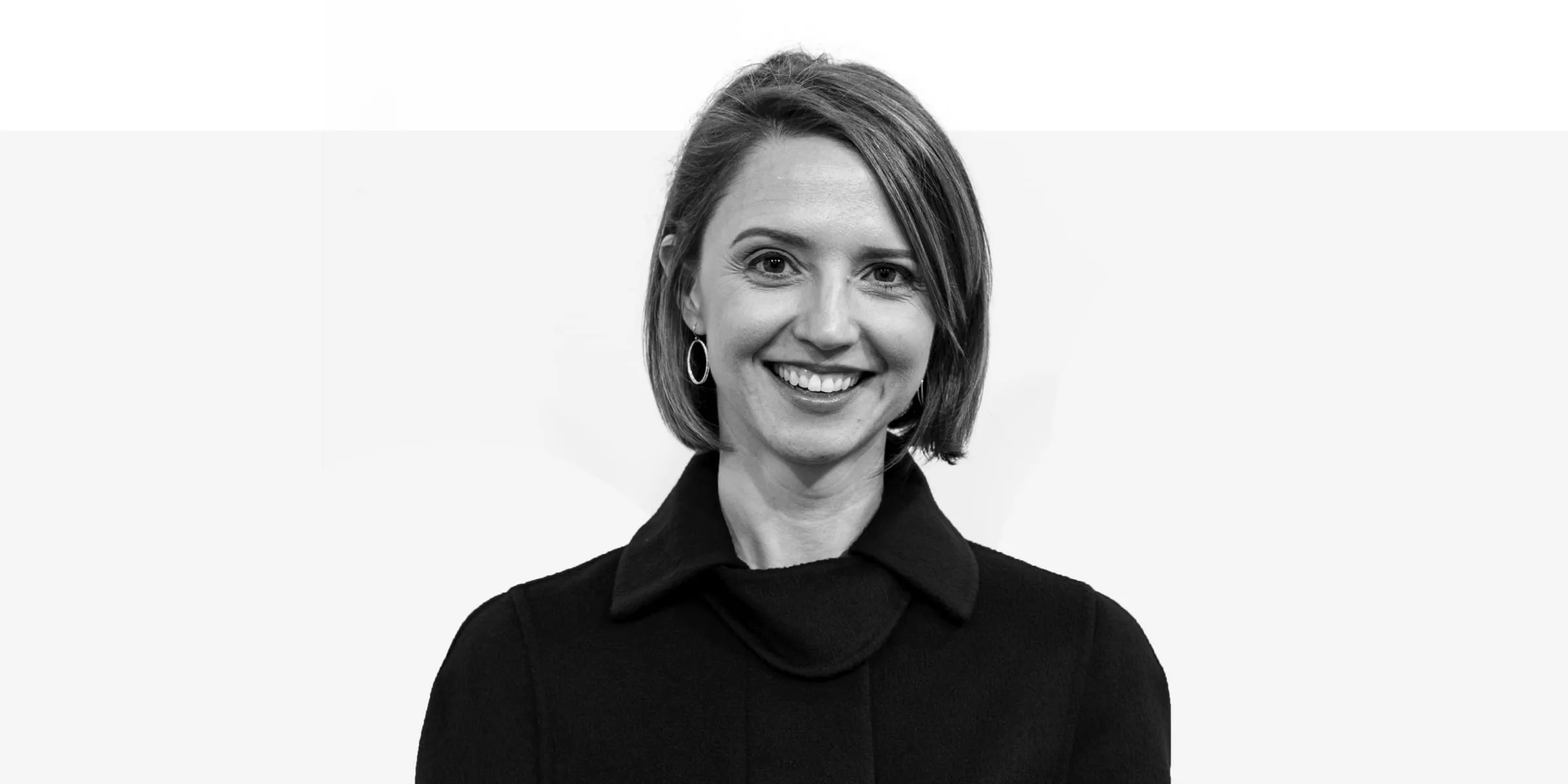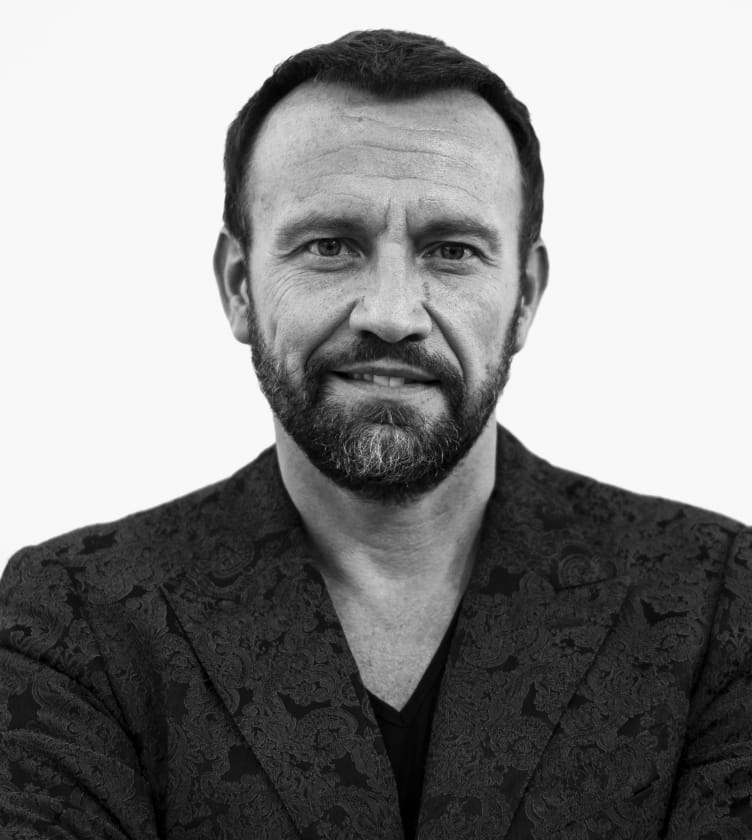Creator and strategist, Jennifer Magnolfi, designs offices that integrate machine intelligence but still have a heart.
Jennifer Magnolfi, the founder of Programmable Habitats, a research and development consultancy that specializes in developing high-tech work environments, talks to us about integrating technology systems and data into architecture, as well as the importance of solitude and reflection within an urban context.
Having collaborated on corporate redesigns and strategic initiatives for companies including Alphabet, Microsoft, and Zappos, Magnolfi shares her expertise on future planning, particularly around the research of “lead users” and how the new tech workforce is reshaping the workspace.
Read more about what Mangnolfi envisions the future of work will look like in 2030.
SPENCER BAILEY: Welcome to the podcast, Jennifer. It’s great to have you here today.
JENNIFER MAGNOLFI: Thanks for having me. It’s great to be here.
SB: I wanted to start on the subject of programmability and really defining what that means. You run a company called Programmable Habitats. What is programmability to you?
JM: Programmability in itself is the fundamental property of digital space. I posit and have been for a while exploring this idea that, more and more, as technology begins to integrate into not just the way we work and therefore sort of code how we work, [it] really begins to integrate into the very materials of the built environment. So, starting from the technology systems in a building, whether it’s energy management, fire protection, safety, or the actual fabric and material—the walls, the interior partitions, the furniture itself—[there is] the capacity of being able to connect all of these things in various different ways for various different purposes. The net result is an environment that feels programmable and in many cases can be controlled and designed to perform as a programmable space.
SB: I want to talk about time in this context because the time-scale gap between software and architecture clearly has upended how we think about what an office or workspace even is. What’s your perspective when it comes to time and understanding that gap between the two, between software and architecture?
JM: It’s the crucial thing, isn’t it? In my work, I look at, generally, corporate headquarters, but environments that have to, by their own definition, think about the future. So they are designed—either for large strategic business reasons or symbolic reasons nevertheless—but environments that will be built just by the nature of the time it takes to design them and actually occupy them for ten, fifteen years down the road.
So by the time some of these contexts are realized, you’re usually looking at a five-, in a good case, ten-year horizon in an average case. And the question that people who are responsible—whether it’s corporate real estate executives, chief information officers, chief technology officers, as well as, obviously, the owners or the executives of the company—is really asking the question of how do we make this kind of investment with these types of resources, and make sure it’s still relevant five years, ten years down the road, and is no longer obsolete? Because the speed of change of technology is so fast relative to the speed of architecture and to the time that is required to literally construct buildings, certainly at a certain scale.
So that notion of time is the key problem that you contend with. Executives make considerable investments into these buildings, and they do it for many reasons. But that question is always an unknown. In my work, I take a specific approach. I look at what I believe to be future lead users that give us an insight into the future design requirements for these workers.
SB: Who are some of these lead users? I mean, are we talking astronauts? [Laughs]
JM: [Laughs] When I was still in grad school… Early on—I don’t know how, and I don’t remember why—but I was always driven by what I call lead users. People who seem to be solving future problems, problems that the rest of us may not be facing.
And so, in my early work, it was astronauts, actually. [Laughter] In my early work, I did study people who worked in contexts that were by definition extreme. So not the average workspaces, not the average workers, but people who had to, by the very nature of their work, be immersed in highly technological environments, whether it was submarines, whether it was the ISS, outposts in the South Pole and other environments—laboratories, mission control rooms—those kinds of spaces that were very specific, centralized types of technology environments, but where workers couldn’t perform unless they were extremely adept at manipulating the technology systems around them, and where the technology systems really constituted a habitat itself.
So, those types of lead users are obviously few and far between. I think the astronaut corps is around two hundred people since the whole program started. We’re looking at a very small sample base. My work in general evolved from there. The constant has been to look at people who are lead users in the context of technology.
SB: So this new tech workforce, we’re kind of now in the third decade, if we look at [it] from when Google and Apple came onto the scene. How are you viewing these workers in the context of the modern workspace?
JM: My lead users have always been… In a sense, it has been very much a choice that was self-directed. I observed and looked at the world in the contexts that I inhabited—which were arguably not mainstream contexts, just by virtue of the studies that I did and the things that I was interested in—so hacker spaces, robotics labs, or maker spaces, a few years ago, the kinds of environments that were not the mainstream office, but where a lot of my friends were and where I liked to hang out and I liked to get my work done (and some cases would get my best work done) in those environments. So the lead user himself or herself has changed over the last couple of decades.
But the key thread for me has always been who are the types of users that seem to innovate using technology in ways that the average user doesn’t quite do yet? So, today, I study teenagers, as an example, because I am working in projects that will be occupied in 2030. So they’re environments that will welcome a workforce that currently is still in school.
SB: Yeah, I think obviously this idea of… Let’s just take the Apple Park, because you wrote a piece about that in the Harvard Business Review. It’s an interesting example of how we work now in the sense that it’s this large open space. It’s about connecting to nature. It is mostly open-plan. It’s circular—it’s very nontraditional in that sense. Yet it still is this hulking building that is not necessarily designed to move or shift or be flexible in any way, shape, or form. So I guess when it comes to that idea of flexibility today, how do you view Apple Park and, beyond that, how do you view just how workspaces are are shifting?
JM: If you abstract and you sort of zoom out and look at what the technology workspace has had to deliver to companies over the last thirty years, I believe that we’ve seen two structural shifts and we’re at the beginning of a third one. The first shift was probably in 1998 or so. That’s where I would date it. So when founders like Larry Page and Sergey Brin [of Google] began to develop companies and organize themselves to unlock the potential of a technology. In that time, it was the internet, right?
They had to create and they had to have a workspace that allowed them to work in such a way that they could literally build the system. They and many like them, right? So, inspired by Silicon Valley and founders before them and this sort of ethos of technology collaboration between government and private sector and academia, they developed a workspace that became the new baseline, which was informal attire, informal deal-making, spaces that foster collaboration and collisions, a penchant for openness. Therefore, the open plan sort of became—
SB: Incorporating nature. It goes back to the Whole Earth Catalog.
JM: That’s correct. Exactly.
So that created a baseline and in many ways, one could argue, for the last fifteen years or so, it became, over time, the type of workspace many other industries and companies wanted to emulate. But if you look at just one decade later—so the shift of 2007, 2008—you have the introduction of the iPhone. You have, therefore, real mobility that is unlocked. You have free consumer products that would allow a whole host of productivity suites for workers, whether it’s Google apps, whether it’s Microsoft, whether it’s other, different types of tools that enabled workers in a true sense, for the first time, to be mobile. And the real challenge businesses were trying to unlock then was mobility: How do we leverage and unlock the potential of mobility to compete?
Not surprisingly, that was the emergence of coworking spaces—environments that were decentralized, that housed mobile workers, that were entirely designed for that new worker. And if you look now—so ten years later, again—what in 2008 became and created a new baseline, globally at this point, because very successful coworking ventures spread throughout the world and set this new benchmark, this new model. So the introduction of the community manager, it was a figure that didn’t exist in workspaces thirty years ago.
SB: Sounds like a Facebook term. [Laughs]
JM: [Laughs] Well, it is, right? So it is taken by digital communities and by digital spaces. But when you have a coworking space with hundreds of companies collaborating, and by the very definition environments that pride themselves into accelerating learning of their occupants. So if you come here, if you’re here, we will connect you, your professional network will amplify, you will be able to collaborate with people outside of your startup. That promise has to be managed and therefore deployed and implemented. So somebody has to do it. You see real innovation emerge where a new function emerges to meet it. And that’s exactly what has happened. And now many environments have that.
Today, the challenge for businesses—and I think this is the real structural shift for us today—is the ability to unlock the potential of machine intelligence. We are entering the phase of machine intelligence. We’re sort of at the beginning. Since 2017, I would say, is the real beginning of contending with machines that have various degrees of intelligence. So businesses today that are thinking about fifteen, twenty years down the road and how they’re going to compete and stay relevant are going to have to understand how to unlock human/machine collaboration for their business, for their customers, for their own values. That takes multiple different shapes and forms and sizes of course.
SB: I have to bring up the human question…
JM: Sure.
SB: Because, and you’ve pointed this out previously, one of the most important, if not the most important aspects of office life, is face-to-face interaction.
JM: For sure.
SB: And what you’re talking about has a lot to do with screens—and of course we’re going through a profound structural shift [in] how we all work—but I think there’s this idea of creating human spaces, spaces that are meaningful for work, and also taking in this abundance that we have now of information, of data, communication. How do you see all this coalescing? In other words, or simply put, how do we make offices that, yes, are all about this machine intelligence, but also, at their heart, are still deeply human?
JM: Deeply human. Yeah. I would only hope very, very deeply human. We’ve seen shifts like this before in history. This isn’t something that we haven’t faced before in many ways, in terms of humankind, for sure.
SB: Yeah, I mean, we’re only a few decades away from like Kubrick films. It’s not…
JM: Exactly, very true.
I tend to perhaps romanticize this in my mind, but I tend to think that we might begin to see companies that have investments in A.I. and in technologies, and therefore have to rely on a workforce that is extremely skilled at manipulating machine assistance, integrating it, understanding it, programming it. They have to create environments that foster the learning—and really, the development—of human capital. So it’s not just the frontiers of machine work, but it’s really the frontiers of human work.
Creating environments that try to balance this somewhat mechanistic—but certainly, you can use the word artificial just because that’s the sort of vernacular that we use—but machine context and what is required for that. And the uplifting of all of the different dimensions that in fact make us human. Which have nothing to do with machines: our ability to love, our ability to trust, to have hope or faith, to believe in one another, or in a vision or in a purpose. Those remain—I don’t want to say, because I’m not qualified to say that, that they are things that cannot be reproduced by a machine, but they certainly are things that we recognize as definitively human. And so it is inevitable that these future contexts will have to, in no different way than old universities and campuses cultivated these aspects of humankind, human nature—cultures, civilizations, societies—integrate this as part of the workspace.
So I think you will see in the future, either the distributed corporate campus deeply integrated in the urban fabric that won’t be highly distinguishable from a network of coworking spaces—but it will just simply be governed and owned by one entity, a distributed network of workspaces within the heart of their city. Or [we’ll see] the opposite: places that are idyllic, in nature, connected by virtue of the fact that today we are connected globally (we can be anywhere, working on a remote island, on a boat, anywhere). But [spaces] that emphasize those kinds of aspects of nature and solitude, the ability to think, the ability to slow down time and humanize time, all of those things that is more difficult to do in an urban context.
SB: Design-wise, what are some solutions that you see happening or that are sort of unfolding right now that you think are really interesting and illustrative of where things are headed?
JM: I always, in my work, focus on the user, himself or herself. I look at the user as the key to unlock the design principles that will come. So, for example, a few years ago, I would posit that the user—and this is very true from the users that I study today—they enter a cognitive state of work. These are users that are fully adept at working in the subway, on an airplane, wherever they are, as long as they have access to their data, right? Through whatever device they access their data.
But they enter a cognitive state of work—and specifically teamwork—when data is spatialized. So really, their physical bodies are almost surrounded by it. That changes everything. It creates a specific distinction of working on the go, which is a mix of all of your social spaces, digital spaces, all enmeshed, accessible at your own leisure, in whatever way you command. But when data is spatialized, it’s because you’re going to a specific environment that you inhabit, that creates a different set of assumptions. So, more and more, you begin to see that as a design requirement.
But I look at, specifically, at other kinds of behaviors that are essential for this future worker to perform. So by default they manage their teams as networks. They have an intrinsic understanding of how networks perform because they have inhabited social networks, digital networks, from a very early age. So their assumption is that information, whether it’s coming from a machine or a human to member, is coming in a distributed way, which changes entirely the way they approach problem-solving, course-of-action selection, brainstorming as a whole, these syntheses of data. And then there’s another aspect, which is the way they manage their work is like startups.
You see that these are performance-drivers, right? They need to be able to be in a workspace—and therefore work in a work culture—that promotes this type of work and this kind of approach to work. Many of them, the high performers, have almost an intuitive understanding, in real time, of machines. They can read code in real time. They use words like empathy or trust when it comes to their bots or when it comes to their robots. They intuitively adapt their assumptions about work and performance based on this new kind of work reality.
So when you ask me what design things you see promising, I can only say the first one, because you begin to see it as a baseline for these new future user. Digital information to be specialized—done. Contexts and environments where the team and all of the collaborators within or outside of the organization are in network—that has to be mobilized and that has to be harnessed in order to achieve a goal. And the way that’s done is different than command-and-control, centralized patterns of work. So the design principles today are at a business level, at the core of how you organize your organizations and how you organize a business.
I think it’s still too early, at least for the users that I study, to begin to see canonical design principles, beyond the normal ones, right? So designing an environment for maximizing adaptation where the user can be a co-designer, where time-to-change would be ideally zero, where you create a context where you’re literally housing a network of both humans and machines collaborating. These are what I, in my work, consider sort of state-of-facts environments. You can’t really design for future workspace unless you integrate those. But when it comes to more fine-tuning of design principles, I think it’s still quite early.
It’s very exciting to begin to see what I think of as a new chapter in the world of designing a workspace, because the rules really haven’t been written. They’re just very much emerging still.
SB: I think we’ll have to get back together in ten years from now—have our 2028 conversation. [Laughs]
JM: [Laughs] It might be much sooner than that. The way things are going, it might be—
SB: Half-time.
JM: Half-time.
SB: Thanks, Jennifer. It was great having you in here today. Thanks.
JM: Thank you so much.




